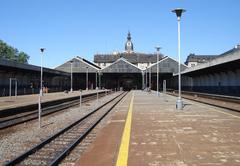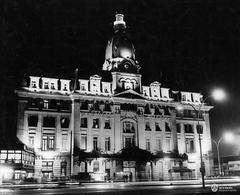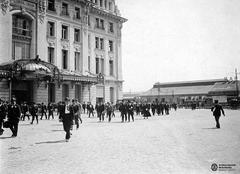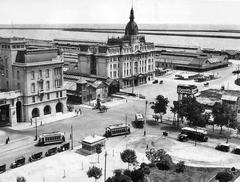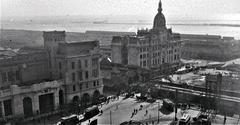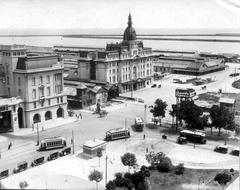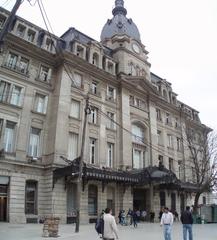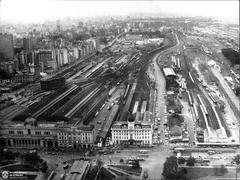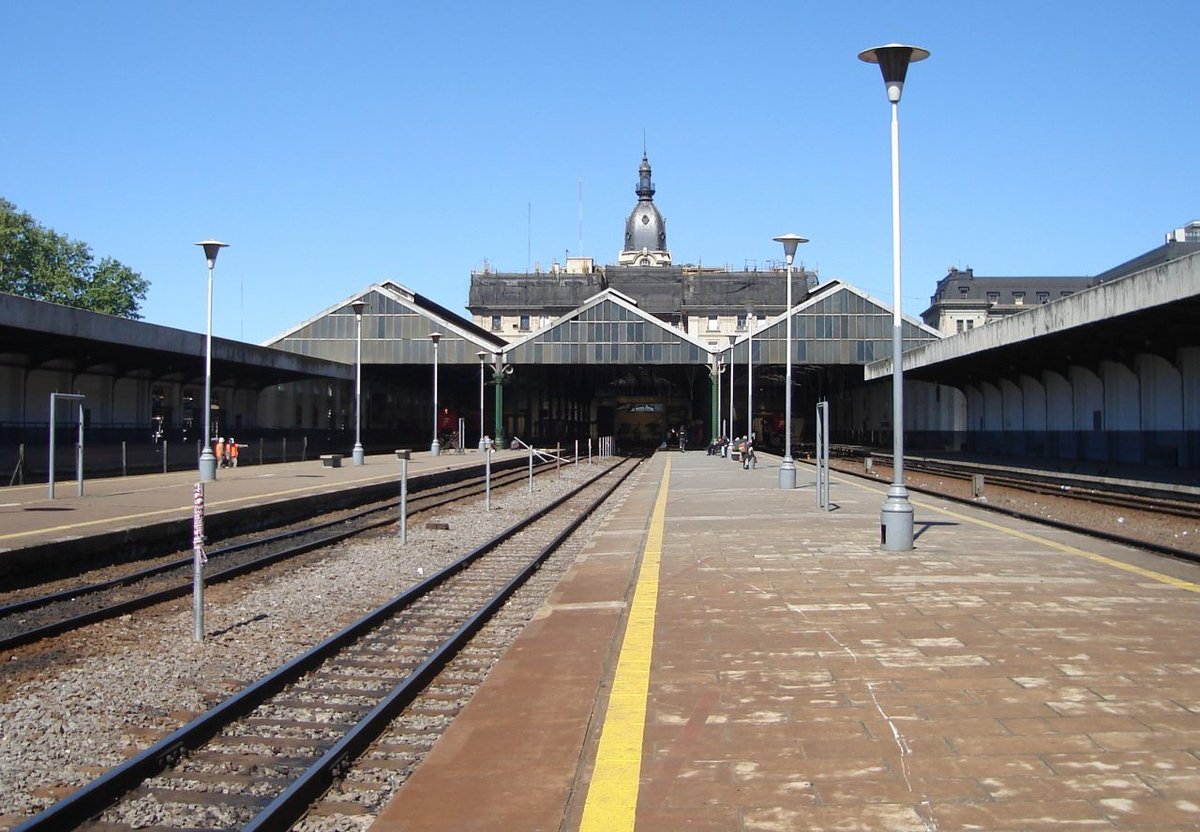
Retiro Belgrano Train Station Buenos Aires: Visiting Hours, Tickets, and Comprehensive Travel Guide
Date: 14/06/2025
Introduction
Retiro Belgrano Train Station, located in the vibrant Retiro district of Buenos Aires, is both a functional transportation hub and a striking symbol of Argentina’s railway heritage. Renowned for its French Academicist architecture, the station serves as the terminus of the Belgrano Norte Line and forms part of a broader transport complex that seamlessly connects suburban trains, the subway, and long-distance buses. Visitors to this landmark can immerse themselves in a rich blend of architectural beauty, history, and urban connectivity, making Retiro Belgrano a must-see for travelers and history enthusiasts alike (Wikipedia - Retiro Belgrano railway station, Turismo Buenos Aires - Retiro Station).
Table of Contents
- Origins and Historical Development
- Architectural Significance
- Visiting Hours and Ticket Information
- Facilities and Accessibility
- Urban Context and Connectivity
- Safety and Visitor Tips
- Notable Events and Restoration
- Nearby Attractions
- Frequently Asked Questions (FAQ)
- References and Further Reading
1. Origins and Historical Development
Retiro Belgrano Train Station, or Estación Retiro Belgrano, was originally built as part of the Córdoba Central Railway’s early 20th-century expansion, linking Rosario and Córdoba with Buenos Aires. Construction began in the 1910s, and by 1912, trains were arriving in Buenos Aires. The station’s grandeur grew alongside the city’s ambitions, culminating in the 1914 completion of its iconic dome and expansive halls. Over subsequent decades, Retiro Belgrano became central to both suburban commuting and long-distance travel, hosting legendary services such as “El Norteño” and “El Chaqueño” (Wikipedia - Retiro Belgrano railway station, For91days - Retiro Train Station).
In May 2021, Retiro Belgrano was declared a National Historic Monument, further cementing its status as a cornerstone of Argentina’s transport and architectural legacy (Wikipedia - Retiro Belgrano railway station).
2. Architectural Significance
The station is a prime example of French Academicist and Beaux-Arts architecture, a style that flourished in Buenos Aires during the early 1900s. Designed by Louis Faure Dujarric and Robert Prentice, the building features:
- A Grand Central Hall with imported materials assembled on-site, reminiscent of major European train stations (Turismo Buenos Aires - Retiro Station).
- A Distinctive Dome and Clock—added in 1914—visible across the neighborhood (Wikipedia - Estación Retiro Belgrano).
- Extensive Iron Platform Canopies, notable for their engineering and scale (For91days - Retiro Train Station).
- Ornate French Detailing, including classical motifs, pilasters, and decorative moldings.
The station’s design reflects Buenos Aires’ cosmopolitan aspirations during the Belle Époque, paralleling other city landmarks such as Teatro Colón.
3. Visiting Hours and Ticket Information
- Station Hours: Open daily from 5:00 AM to 11:00 PM. Train services may vary by day and destination; check schedules in advance (Trenes Argentinos Official Website).
- Ticketing: Purchase tickets at station counters, via automated machines, or online. The SUBE card—a rechargeable, contactless fare card—is required for suburban lines and is available at kiosks citywide and within the station. Fares depend on distance and service class.
- Long-Distance Tickets: For extended routes, buy tickets at official counters or authorized online platforms.
4. Facilities and Accessibility
- Amenities: Waiting areas, restrooms, kiosks, and clear signage.
- Accessibility: Ramps, elevators, and tactile flooring support passengers with reduced mobility.
- Language Support: Signage is mainly in Spanish; basic English may be available at ticket counters. Consider using translation apps for added support (The Thorough Tripper).
5. Urban Context and Connectivity
Retiro Belgrano is integral to the city’s broader transport network:
- Subway (Subte): Direct access to Line C (and Line E since 2019), with future plans for Line H expansion.
- Buses: Numerous city bus lines serve the station.
- Long-Distance Bus Terminal: Adjacent to the station, offering regional and international travel.
- Intermodality: The station is part of the AMBA rail network, connecting commuters to neighborhoods like Vicente López, San Isidro, and Pilar (Ferrovías and Trenes Argentinos).
6. Safety and Visitor Tips
- Daytime: The area is generally safe, especially near Plaza San Martín and main avenues.
- Night: Exercise added caution after dark. Avoid poorly lit areas and the vicinity of Villa 31, a nearby informal settlement.
- Pickpocketing: Remain vigilant for petty theft, especially during rush hour.
- Transport: Use official taxis or ride-hailing apps (Uber, Cabify), especially at night.
- Emergencies: Police and station security are present; the emergency number is 911.
Additional safety tips can be found at Say Hueque and Worldly Adventurer.
7. Notable Events and Restoration
- 1912–1914: Construction and expansion, including the dome.
- 2011: Major restoration of façade, dome, and mechanical systems (Wikipedia - Estación Retiro Belgrano).
- 2021: Declared a National Historic Monument.
- 2023–2024: Ongoing modernization under the Rail Transport Modernisation Plan, including upgrades to platforms, lighting, and signaling (Railway Gazette - Retiro Terminus Modernisation).
8. Nearby Attractions
- Plaza San Martín: Lush park with historical monuments.
- Torre Monumental: Iconic clock tower offering panoramic city views.
- Florida Street: Pedestrian shopping corridor.
- Recoleta: Upscale neighborhood known for its cemetery, museums, and Parisian-style architecture.
- Teatro Colón: World-renowned opera house, a short walk or bus ride away.
- MALBA: Museum of Latin American Art, easily accessible from Retiro.
9. Frequently Asked Questions (FAQ)
Q: What are the visiting hours for Retiro Belgrano?
A: Open daily from 5:00 AM to 11:00 PM.
Q: How do I buy train tickets?
A: Use the SUBE card, available and rechargeable at kiosks and inside the station.
Q: Is the station accessible?
A: Yes, there are ramps, elevators, and accessible restrooms.
Q: Is it safe to visit at night?
A: Exercise caution after dark and avoid less familiar areas.
Q: Are there guided tours?
A: Official tours are rare, but local operators offer neighborhood walks focusing on architecture and history.
10. References and Further Reading
- Retiro Belgrano railway station, 2025, Wikipedia
- Estación Retiro Belgrano, 2025, Wikipedia
- Retiro Train Station, 2025, For91days
- Retiro Station, 2025, Turismo Buenos Aires
- Trenes Argentinos Official Website, 2025
- Retiro Terminus Modernisation, 2023, Railway Gazette
- Ferrovías (Moovit)
- Sol Salute – Trains in Argentina
- The Thorough Tripper – Buenos Aires Travel Tips
- Say Hueque – Buenos Aires Train Station
- The Chaos Diaries – Buenos Aires Neighborhood Safety
- Worldly Adventurer – Is Buenos Aires Safe?
Final Recommendations
For a rewarding and safe experience at Retiro Belgrano Train Station, plan your visit during daylight hours, keep your belongings secure, use official transport options, and take time to enjoy the historical and cultural sights nearby. Enhance your journey with travel apps such as Audiala for real-time schedules and audio guides.
Experience Buenos Aires at its crossroads of history and modernity—where every journey begins with a story.
